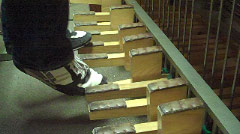Frequently Asked Questions
Questions:
- What is a carillon and where are the bells?
- How do you pronounce "carillon?"
- What is the difference between a carillon and chimes?
- How big are the bells?
- How high are they?
- Why is it called the Hopeman Memorial Carillon?
- What happened to the original chimes?
- How far away do the bells sound out? Are they amplified?
- How many carillons exist in the United States? In New York?
- Do you play it every time the quarter hour sounds?
- How do you practice?
- What does the music look like and how is it played?
- Do you take requests?
What is a carillon and where are the bells?
A carillon is a musical instrument that consists of a set of at least 23 bells that have been precisely tuned to produce the notes of a western scale. The bells are typically housed in a tower, either as part of some other building like a church, state building, or library, or as a separate structure built specifically to house the bells.
There are also “portable” carillons in which the bells are held in a large frame on wheels; these carillons are usually much smaller and lighter than regular tower carillons. Someone who plays the carillon is known as a “carillonneur” or “carillonist.”
Provided by Gabriel Fanelli and Blair Germain
The Hopeman Memorial Carillon is housed at the very top of Rush Rhees library. It consists of 50 bells which sound (in Helmholtz notation): G A# c d e – c’’’’ (the HMC is fully chromatic between e and c’’’’)
The keyboard to the bells, while it resembles the layout of a piano or organ, is really two rows of wooden batons coupled with a set of pedals that control the lower octaves of the keyboard. This is collectively known as the “console,” with the upper rows of batons called “manuals” and the lower controls called “pedals.”


How do you pronounce, "carillon?"
“care´-il-on,” with the accent on the first syllable.

Dutch craftsmen install the
carillon in 1973
What is the difference between a carillon and chimes?
A chime usually is an instrument that consists of anywhere from 8 to 22 bells, chromatic or diatonic. A carillon has over 23 bells and is in almost all cases nearly-fully chromatic (most carillons leave out the lowest chromatic notes, as they are not frequently used).
Carillons have several advantages over chimes, including:
- A wider repertoire that can be played
- A wider range of tones
- An instrument more sensitive to human touch
How big are the bells?
The bells weigh a total of 6,668 pounds, making this instrument one of the lightest in its class! In comparison the heaviest bell alone of the original chime weighed 7,800 pounds.
How high are they?
Rush Rhees tower reaches to 186 feet above the ground. The bells are housed in the upper-most chamber at the top of the tower.
Why is it called the Hopeman Memorial Carillon?
The Hopeman Memorial Chime was given in memory of Arendt W. Hopeman, the general contractor to the River Campus from 1927-30.
What happened to the original chimes?
The six smallest bells of the old chime were given to Christ Church Episcopal at East Avenue and Scio Street in Rochester. The remaining bells were taken by the Eijsbouts company back to the Netherlands where they were melted down for use in repairing and building other carillons.
How far away do they sound out? Are they amplified?
Depending on the weather, the bells can be heard across the Genesee River. There is no amplification.
How many carillons exist in the United States? In New York?
According to the Guild of Carillonneurs of North America there are 166 traditional carillons in the USA. In New York state, four carillons are located in upstate New York, three in New York City.
Do you play it every time the quarter hour sounds?
Thankfully, no! There is an automatic switch that sounds the Westminster Quarters.
How do you practice?
An exact copy of the console that is in the bell tower resides in a practice room in Spurrier. This console isn’t hooked up to bells, but, rather, a xylophone. Most of the notes of the piece are learned on this instrument, and only when the piece is comfortably “in the student’s body” does the student practice on the real thing.
This allows people to practice privately and not feel the pressure of knowing everyone can hear them, and it also keeps students from subjecting the entire community to many slow repetitions.
What does the music look like and how is it played?
The music is written on a grand staff, like piano music. However, it is the convention that the bottom staff is to be played with the feet, while the top staff is to be played with the hands.
Do you take requests?
Of course! We are always looking to play music that the community would like to hear, whether that’s your favorite movie theme, folk song, holiday carol, or new composition. Submit requests here.
Sources:
